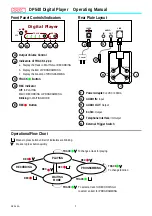
To set the external trigger signal as the arm source:
ARM:SOUR EXT
Setting the Trigger
Counter
The trigger counter controls how many trigger events will be allowed to
start a measurement scan. When the number of trigger events set with the
TRIGger:COUNt
command is reached, the module returns to the trigger idle
state (needs to be
INITiated
again). The default trigger count is 1 (returns to
the trigger idle state after each scan). If
TRIGger:COUNt
is set to
INFinite
,
the trigger counter is disabled and the module will accept an unlimited
number of trigger events.
To set the trigger counter to 100:
TRIG:COUN 100
Can trigger 100 times after a
single INITiate command.
Step 7. Specifying the Data Format
The format of the readings stored in the FIFO buffer and CVT never
changes. They are always stored as IEEE 32-bit floating point numbers.
The
FORMat:DATA <
format
>[,<
length
>]
command merely specifies
whether and how the readings will be converted as they are transferred from
the CVT and FIFO.
•
The <format>[,<length>] parameters can specify:
PACKED
Same as REAL,64 except for the values of
IEEE -INF, IEEE +INF, and Not-a-Number (NaN).
See the
FORMat
command in Chapter 5 for details.
REAL,32
Means real 32-bit (no conversion, fastest)
REAL
Same as above
REAL,64
Means real 64-bit (readings converted)
ASCii,7
Means 7-bit ASCII (readings converted)
ASCii
Same as above (the *RST condition)
To specify that readings are to remain in IEEE 32-bit floating point format
for fastest transfer rate:
FORM:DATA REAL,32
To specify that readings are to be converted to 7-bit ASCII and returned as a
15 character per reading comma separated list:
FORM:DATA ASC,7
or
FORM:DATA ASC
The *RST, *TST? and power-on
default format.
88 Using the HP E1313/E1413
Chapter 3
Artisan Technology Group - Quality Instrumentation ... Guaranteed | (888) 88-SOURCE | www.artisantg.com
















































